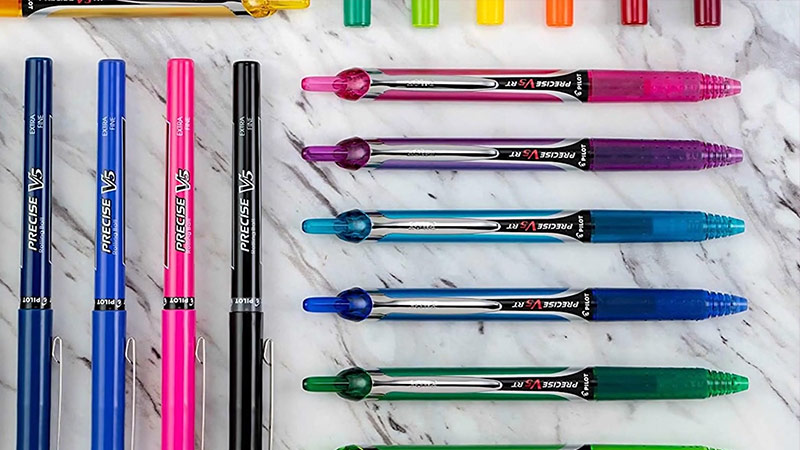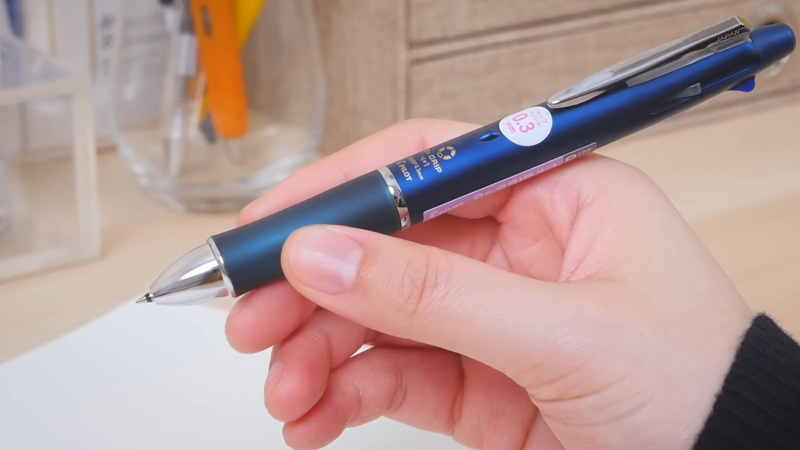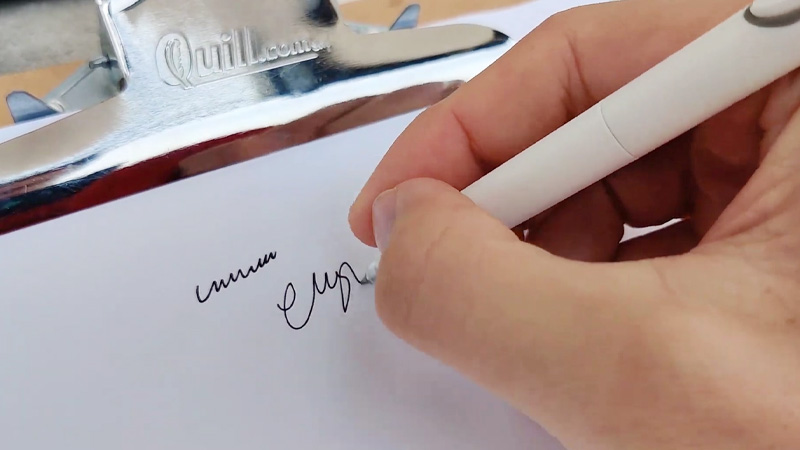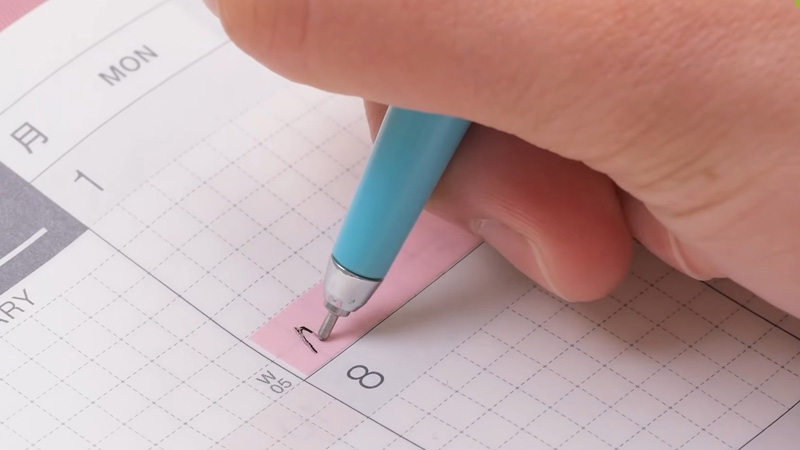The art of origami, the Japanese tradition of paper folding, embodies a delicate fusion of precision and creativity.
Central to this craft is the choice of paper, and among the myriad options, washi origami paper stands out for its rich history and unique texture.
However, when it comes to personalizing origami creations with intricate designs or markings, a common question arises: Does a ballpoint pen work effectively on washi origami paper?
This question unveils an exploration of the compatibility between the graceful, fibrous nature of washi paper and the practicality of a ballpoint pen.
In this exploration, we will delve into the interplay of materials, techniques, and artistic possibilities that arise when these two worlds collide.

Does a Ballpoint Pen Work on Washi Origami Paper?
Yes, a ballpoint pen works on washi-origin paper, and sometimes not. Washi paper, a traditional Japanese paper, is known for its unique texture and strength.
Its fibrous composition gives it a delicate, yet sturdy quality that makes it a popular choice for origami projects.
However, whether or not a ballpoint pen works effectively on this type of paper depends on several factors.
Here they are:
Paper Thickness and Density
Washi paper comes in various thicknesses and densities, and this can greatly affect how well a ballpoint pen works on it. Thicker and denser washi papers are less likely to bleed or feather when written on with a ballpoint pen. Thinner, more delicate washi paper may be more susceptible to ink bleeding through or creating uneven lines.
Ink Quality
The type of ballpoint pen you use matters. High-quality ballpoint pens with a smooth and consistent ink flow tend to work better on washi paper. Cheap or low-quality pens may result in uneven lines, skipping, or ink blotting.
Paper Coating
Some washi paper may have a coating or finish that affects how the ink interacts with it. Uncoated washi paper tends to work better with ballpoint pens, as the ink can absorb the fibers more easily.
Coated or glossy washi paper may cause the ink to sit on the surface, which can lead to smudging.
Ink Drying Time
Ballpoint pen ink typically dries quickly, which can be an advantage when working with washi paper. However, if you need to make precise or detailed drawings, it’s essential to allow the ink to dry completely to prevent smudging or smearing.
Pen Pressure
When using a ballpoint pen on washi paper, it’s important to apply a consistent, light pressure. Excessive pressure can cause the pen to dig into the paper, creating unintended creases or tears.
Testing
Before starting your origami project or artwork, it’s a good idea to do a small test on a scrap piece of the same washi paper.
This will help you determine how the pen interacts with the paper and whether any adjustments are needed.
How Does a Ballpoint Pen Work?

A ballpoint pen is a common writing instrument that utilizes a small ball bearing to transfer ink onto paper as you write.
It works through a straightforward mechanism that involves the flow of ink from a reservoir to the paper.
Here’s a step-by-step explanation of how a ballpoint pen works:
Ink Reservoir
The ink reservoir is a crucial component of the ballpoint pen. It contains a supply of ink that is stored in a closed system to prevent drying and leakage.
In disposable pens, this reservoir is often an integrated chamber, while in refillable pens, it typically consists of a replaceable ink cartridge that can be swapped out when the ink is depleted.
Ballpoint Tip
The ballpoint tip is positioned at the end of the pen and is typically made of a very hard material, such as steel or tungsten carbide.
Its small size and hardness allow it to roll smoothly over the paper while maintaining its shape, which is essential for consistent writing.
Ink Viscosity
The ink inside the reservoir is specially formulated to have a specific viscosity that strikes a balance between being thick enough to prevent unintended leakage and thin enough to flow when needed.
This consistency ensures that the ink does not spill out of the pen while it’s not in use.
Capillary Action
Capillary action is a fundamental principle of fluid dynamics. In this context, it describes how the ink is drawn from the reservoir onto the paper.
As the ball rotates and moves across the paper’s surface, it creates a tiny gap between itself and the paper. This gap allows the ink to be pulled out due to the capillary effect.
Ink Transfer
The ink is transferred from the reservoir onto the paper as it flows through the capillary channel created by the rolling ball.
The ball serves as a controlled conduit for the ink, ensuring that only a small amount is deposited onto the paper’s surface.
Writing on Paper
When the ball moves across the paper, it leaves a fine line of ink behind. The ink adheres to the paper because of its adhesive properties, which help it bond with the paper fibers.
Ball Rotation
The ball is engineered to rotate freely within its socket. This rotation prevents it from wearing down too quickly, and it also ensures that the ink is evenly distributed onto the paper as it rolls.
Drying
The ink used in ballpoint pens is formulated to dry quickly on paper. This quick-drying property prevents smudging and allows the writing to remain clear and legible.
Pressure Control
The width and intensity of the line produced by a ballpoint pen can be controlled by adjusting the pressure applied while writing.
Applying more pressure results in a broader and darker line, while lighter pressure creates finer lines.
Capping
To maintain the functionality of a ballpoint pen and prevent ink from drying out, it’s essential to cap the pen when it’s not in use.
The cap seals the tip and prevents air from entering the reservoir, which could otherwise lead to ink drying out and rendering the pen unusable.
Do Ballpoint Pens Smear?

Yes, ballpoint pens can smear under certain circumstances. The likelihood of smearing with a ballpoint pen depends on various factors, including the type of paper, the quality of the pen, and the speed of writing.
Here are some key considerations regarding smearing with ballpoint pens:
Paper Type
The type of paper used can significantly affect whether a ballpoint pen smears. Porous and absorbent papers, such as newsprint or low-quality notebook paper, are more prone to smearing because the ink takes longer to dry and can be absorbed by the paper fibers.
In contrast, smoother and coated papers, like high-quality printer paper or glossy magazine pages, are less likely to smear because the ink dries faster on their surfaces.
Ink Quality
The quality of the ink in the pen matters. High-quality ballpoint pens often use quick-drying ink formulations that are less prone to smudging.
Cheaper or low-quality ballpoint pens may use inks that take longer to dry and are more susceptible to smearing.
Drying Time
Ballpoint pen ink typically dries relatively quickly compared to other types of ink, such as gel or liquid ink.
However, it’s essential to give the ink a moment to dry on the paper before touching it, especially if you’ve written a large amount of text or made bold strokes.
Pressure and Speed
The amount of pressure applied when writing and the speed at which you write can influence smearing.
If you press down heavily on the paper or write quickly, you may increase the chances of smudging because the ink doesn’t have enough time to dry before your hand or another surface comes into contact with it.
Ink Color
Some ink colors, such as black and blue, may be less prone to smudging compared to lighter or more vibrant colors.
This is because darker inks often contain more pigments that can adhere to the paper’s surface better.
Environmental Conditions
Humidity and temperature can also play a role in smearing. High humidity levels can slow down the drying process, potentially increasing the chances of smudging. Conversely, drier conditions can promote faster ink drying.
To minimize smearing with a ballpoint pen, consider the following tips:
- Use high-quality ballpoint pens with quick-drying ink.
- Select paper that is less prone to ink absorption and has a smooth surface.
- Allow the ink to dry for a few seconds before touching the paper.
- Write with a light touch and at a moderate pace.
- Avoid writing on paper that is damp or in high-humidity environments.
Can You Write on Washi Tape?

Writing on washi tape can be a bit challenging due to its unique texture and adhesive properties, but it is possible.
Washi tape is a decorative and often translucent adhesive tape made from Japanese washi paper.
Here are some tips on how to write on washi tape effectively:
Use a Fine-Point Pen
To achieve legible writing on washi tape, it’s best to use a fine-point pen or marker. Fine-tip markers, gel pens, or micro-tip pens work well because they can provide precise lines.
Test First
Before applying the tape to your project or surface, it’s a good idea to test your pen or marker on a small piece of the tape to see how well it writes and dries.
Surface Preparation
Ensure that the surface of the tape is clean and free of dust or debris. This will help the ink adhere better to the tape.
Steady Hand
Writing on washi tape can be a bit tricky due to its texture and flexibility. Use a steady hand and go slowly to avoid smudging or uneven writing.
Allow Time to Dry
After writing on the tape, give it some time to dry. The drying time may vary depending on the type of ink you used and the thickness of the ink lines. Gel inks and certain markers may take longer to dry than others.
Consider the Tape’s Transparency
Keep in mind that washi tape is often translucent, so the background color or pattern may affect the readability of your writing. You may need to choose your ink color carefully to ensure it contrasts well with the tape.
Practice and Patience
Like any art or craft, writing on washi tape may require some practice to achieve the desired results.
Be patient and experiment with different pens and techniques until you find what works best for your project.
Protect the Writing
If your project requires durability or if you want to ensure the writing doesn’t smudge, consider applying a clear adhesive tape or sealant over the writing once it’s dry. This can help protect the ink from smearing or fading over time.
Does Washi Tape Damage Paper?
Washi tape is generally designed to be a gentle and non-damaging adhesive tape, making it a popular choice for various crafts, scrapbooking, and paper-based projects. When used correctly, washi tape should not damage paper or leave behind residue.
However, there are some considerations to keep in mind:
Surface Quality
The type and quality of paper can influence how washi tape adheres. On most standard papers, such as printer paper or cardstock, washi tape should adhere without causing damage.
However, on very delicate or thin papers, such as tissue paper or rice paper, there is a greater risk of tearing or damaging the paper when applying or removing the tape. It’s essential to be gentle in such cases.
Application and Removal
When applying washi tape, it’s advisable to do so carefully and avoid excessive pulling or tugging on the paper.
Press down on the tape gently to ensure it adheres but without applying excessive pressure. When it comes time to remove the tape, do so slowly and at a low angle, which can help reduce the risk of tearing or damaging the paper.
Aging and Environmental Factors
Over time, the adhesive on washi tape can deteriorate, especially if the tape is exposed to extreme temperatures, humidity, or direct sunlight.
Old or degraded washi tape may become less gentle and may be more likely to leave residue or damage the paper.
Residue
While washi tape is generally designed to be low-residue or residue-free, in some cases, if left on paper for an extended period or exposed to adverse conditions, it may leave a faint adhesive residue.
To minimize this risk, avoid leaving washi tape on paper for prolonged periods, especially if the tape is exposed to heat or humidity.
Surface Preparation
Ensure that the surface of the paper is clean and free of dust or oils before applying washi tape. Contaminants on the paper’s surface can affect the tape’s adhesion and potentially make it more challenging to remove cleanly.
Tips for Writing on Washi Origami Paper
Writing on Washi origami paper can be a delicate and beautiful way to add personalization or messages to your origami creations.
Here are some tips to help you write on Washi origami paper effectively:
Choosing the Right Pen or Marker
Selecting the appropriate writing instrument is crucial when working with delicate Washi origami paper.
Opt for a fine-tipped pen or marker with a light touch. Gel pens, fine-tip permanent markers, and calligraphy pens are ideal choices.
These pens provide precision without applying excessive pressure, which could otherwise damage the fragile paper.
Testing on Scrap Paper
Before you begin writing on your actual origami paper, it’s advisable to conduct a test on a spare piece of Washi paper.
This preliminary step helps you assess whether the chosen pen or marker tends to bleed, feather, or smudge on this unique paper. By doing so, you can avoid any unwanted surprises on your final origami piece.
Writing with Precision
Washi paper’s thin and delicate nature requires a delicate touch while writing. To ensure your writing appears neat and flawless, adopt a slow and steady writing pace. Steer clear of rushed or careless strokes that may result in errors or unintentional damage to the paper.
Practicing Calligraphy
If you possess calligraphy skills, consider employing them to create exquisite and artistic messages on the Washi paper.
Washi’s texture and translucency can enhance the overall aesthetic of your calligraphic writing, adding elegance to your origami creations.
Planning Your Design
Before commencing your origami folding, carefully plan where you intend to write on the Washi paper. It’s generally easier to write on a flat sheet of Washi paper before folding it into an origami shape.
This strategic planning ensures that your message or design aligns perfectly with your final creation.
Keeping It Simple
Washi paper’s unique texture and thinness tend to work best with simple, clean lines and designs.
Elaborate and intricate details may be challenging to execute and may not show up as effectively on this type of paper. Simplicity often highlights the elegance of Washi origami.
Using Pencil Guidelines
For added precision and to minimize the risk of errors, you can lightly sketch pencil guidelines on the Washi paper before writing.
These guidelines can serve as a helpful reference, ensuring your text or design is well-aligned and proportionate. Once you’re satisfied with your writing, you can easily erase the pencil marks.
Allowing Ink to Dry
It’s essential to allow the ink to thoroughly dry before folding or handling the Washi paper. This step helps prevent smudging or the unintentional transfer of ink to other surfaces. Patience in letting the ink dry is crucial to achieving a flawless finish.
Being Mindful of Paper Texture
The unique texture of Washi paper can influence how the ink appears on the surface. Consider experimenting with different types of Washi paper to find the one that best complements your writing style and desired aesthetic.
Incorporating Traditional Designs
To infuse an authentic touch into your origami, consider incorporating traditional Japanese motifs or designs into your writing. This can add cultural depth and uniqueness to your origami projects.
Sealing with Care
If you intend to seal your origami creation with a wax seal, exercise caution to avoid damaging the paper.
Use low-temperature sealing wax and ensure there is no direct contact between the hot wax and the Washi paper to prevent any adverse effects.
Protecting Your Work
After completing your writing, handle the Washi paper with the utmost care to avoid smudging or damaging the ink.
Maintaining a gentle touch when folding or displaying your origami piece is essential to preserving its beauty.
FAQS
Do Different Washi Papers React Differently to Ballpoint Pens?
Yes, different types and brands of washi paper can react differently to ballpoint pens.
Can I Erase Ballpoint Pen Marks on Washi Origami Paper?
Erasing ballpoint pen marks on washi origami paper can be challenging, as the paper is delicate.
What Should I Do If the Ballpoint Pen Skips or Doesn’t Write Smoothly on Washi Paper?
If your ballpoint pen skips or doesn’t write smoothly on washi paper, try gently shaking the pen to encourage ink flow.
Can I Apply Watercolor or Paint Over Ballpoint Pen Drawings on Washi Paper?
Applying watercolor or paint over ballpoint pen drawings on washi paper can be challenging due to the paper’s absorbency and potential for ink smudging.
Can You Use Colored Ballpoint Pens on Washi Origami Paper?
Yes, colored ballpoint pens can be used on washi origami paper to add vibrant and decorative elements to your creations.
Can I Seal Ballpoint Pen Artwork on Washi Paper to Protect it?
Yes, you can seal ballpoint pen artwork on washi paper to protect it from smudging or fading over time.
To Recap
The compatibility of a ballpoint pen with washi origami paper is a dynamic interplay of various factors, ranging from the paper’s thickness and texture to the quality of the pen and the technique employed.
While ballpoint pens can indeed be used effectively on washi origami paper, achieving optimal results requires mindfulness and experimentation.
By selecting the right paper and pen combination, controlling pressure, and allowing for adequate drying time, artists and enthusiasts can harness the delicate beauty of washi paper to enhance their origami creations with intricate designs, personal touches, and expressive artistry.
The meeting of traditional craftsmanship and modern convenience exemplifies how creativity knows no bounds when working with washi origami paper and ballpoint pens.
Leave a Reply